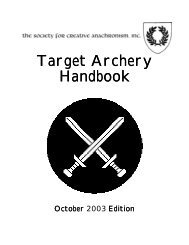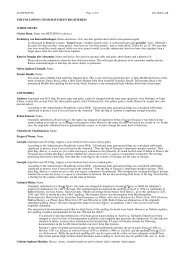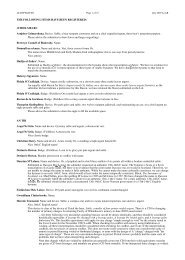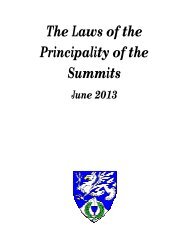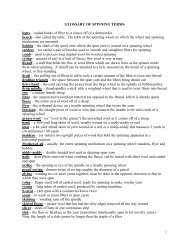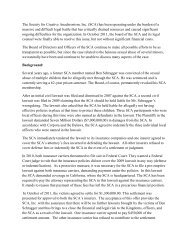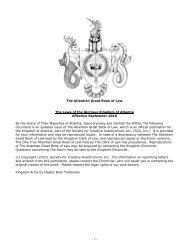The Standards for Evaluation of Names and Armory - SCA Heraldry
The Standards for Evaluation of Names and Armory - SCA Heraldry
The Standards for Evaluation of Names and Armory - SCA Heraldry
You also want an ePaper? Increase the reach of your titles
YUMPU automatically turns print PDFs into web optimized ePapers that Google loves.
<strong>The</strong> <strong>St<strong>and</strong>ards</strong> <strong>for</strong> <strong>Evaluation</strong> <strong>of</strong> <strong>Names</strong> <strong>and</strong> <strong>Armory</strong>:<strong>The</strong> Rules <strong>for</strong> Submissionsthe arrangement <strong>of</strong> the lozenges, because the lozenges in the second design may not be in the center <strong>of</strong> thefield, because they share a tincture with the bottom half <strong>of</strong> the field.For example, there would also be no DC <strong>for</strong> change in arrangement between Gules, in fess three lozengesOr <strong>and</strong> Per fess gules <strong>and</strong> Or, in canton three lozenges two <strong>and</strong> one Or. Even though the relativearrangements are different, the lozenges in the second design cannot be in the same arrangement as in thefirst design. However, there is a DC <strong>for</strong> change in arrangement between Gules, in fess three lozenges Or toPer fess gules <strong>and</strong> argent, in chief three lozenges Or, because the lozenges Or could be in the center <strong>of</strong> aneutral field with which they do not share a tincture.Changes in number can also cause a change in arrangement. In general, changes in arrangement only count<strong>for</strong> difference if the two charge groups are able to have identical arrangements but don't. You maydetermine whether two charge groups have comparable arrangements by referring to Appendix K, whichlists the st<strong>and</strong>ard arrangements <strong>for</strong> charge groups <strong>of</strong> different numbers. If the two charge groups (based onthe number <strong>of</strong> charges within them) can both take on the arrangement the other is in, then the arrangementsare said to be comparable <strong>and</strong> a distinct change can be given <strong>for</strong> the difference between them.For example, two charges in pale <strong>and</strong> three charges in fess have a distinct change <strong>for</strong> difference inarrangement, but neither has a distinct change <strong>for</strong> arrangement against a single central charge.In general, tertiary charges are unlikely to have changes in arrangement, because the shape <strong>of</strong> the chargethey are on limits their placement. One exception to this is a charge group with multiple charges, only one<strong>of</strong> which has a tertiary charge group on it. In this case, there may be a distinct change <strong>for</strong> changing whichportion <strong>of</strong> the charge group has the tertiary.For example, Potent, in pale two roundels gules, the one in chief charged with an eagle Or has one DCfrom Potent, in pale two roundels gules, the one in base charged with an eagle Or.7. Change <strong>of</strong> Posture or Orientation Within a Charge Group: Animate charges have a posture, whichincludes their stance, position <strong>of</strong> limbs, facing, etc.; inanimate charges have an orientation which includestheir radial orientation <strong>and</strong> facing. Distinctly changing the posture or orientation <strong>of</strong> half <strong>of</strong> the charges inany charge group, when the charges are comparable, is one distinct change (DC). Only one distinct changecan be derived from the changes in posture <strong>and</strong>/or orientation <strong>of</strong> any given charge group, though multipledistinct changes can be given <strong>for</strong> independent changes <strong>of</strong> posture or orientation to multiple charge groups.Multiple changes to the posture or orientation <strong>of</strong> the same charges may not be counted separately. Somecharges, such as roundels, do not have a posture or orientation to be compared. In general, changes <strong>of</strong>position <strong>and</strong>/or orientation that considerably change the appearance <strong>of</strong> a single type <strong>of</strong> charge will count <strong>for</strong>a distinct change. Animate charges do not have comparable postures with inanimate charges. A partial list<strong>of</strong> postures <strong>and</strong> orientations that are distinct can be seen in Appendix L.For example, changing a sword fesswise to a sword palewise or a lion rampant to a lion passant is one DC.Similarly, a lion passant bendwise is only one DC from a lion couchant contourny. For example, while alion passant may be mostly fesswise, there is not a DC <strong>for</strong> change <strong>of</strong> posture between a lion passant <strong>and</strong> asword palewise.a. Change <strong>of</strong> Posture <strong>for</strong> Animate Charges: Animate charges are considered to fall into categories by thetype <strong>of</strong> animal <strong>for</strong> posture. Quadrupeds have comparable postures, birds have comparable postures,insects <strong>and</strong> other creatures normally found in tergiant positions have comparable postures, fish havecomparable postures. Animate charges which fall into separate categories do not have comparablepostures.For example, there is not a DC <strong>for</strong> change <strong>of</strong> posture between a griffin segreant <strong>and</strong> an eagle displayed,although one is to dexter <strong>and</strong> the other affronty, because while a griffin could be described as displayed,<strong>St<strong>and</strong>ards</strong> <strong>for</strong> <strong>Evaluation</strong> <strong>of</strong> <strong>Names</strong> <strong>and</strong> <strong>Armory</strong> – April 29, 2012 - Page 65 <strong>of</strong> 73



